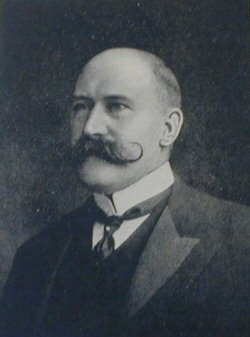 EDMUND
SHARER
EDMUND
SHARERTHE Director and General Manager of the shipbuilding yards of Messrs. William Beardmore & Company, Ltd., comes of a shipbuilding race. His grandfather, Thomas Sharer, a native of the east of Scotland, was for thirty-three years manager of Laing's shipbuilding yard at Sunderland. He was succeeded in the post by his son George, but the latter presently left Sunderland for Greenock, where he joined Robert Taylerson, inventor of the diagonal method of planking ships. The grandson, though born in Sunderland, spent his childhood in Greenock, and received most of his education at St. Andrews. He began business life as an apprentice in the shipbuilding yard of the late Robert Duncan at Port-Glasgow. In 1879, in his twenty-second year, he was appointed Surveyor to Lloyd's Registry at Liverpool, but a year later began business as a shipbuilder in his native place, Sunderland. The first set of triple-expansion, twin-screw engines ever seen on the Caspian was sent out by him in 1886, and shortly afterwards, at the invitation of the Russian governor, he himself went out to Baku to instruct the engineers there in the proper method of working them. On his return he was asked to become manager of Sir Raylton Dixon's work at Middlesborough, but he had already accepted a partnership with Messrs. Edwards' shipbuilding firm on the Tyne. Seven years later, in 1893, he accepted the general management of the famous Fairfield yard on the Clyde. At that time, following the death of Sir William Pearce, the fortunes of Fairfield had reached a very low ebb - only one vessel, a sailing ship, was on the stocks. Under Mr. Sharer's direction, however, and that of Mr. Gracie, head of the engineering department, the old prosperity presently came back, and during the next six years, besides other vessels, the yard turned out four first-class and four second-class cruisers, ten torpedo-boat destroyers, and eight large steamers for the Castle Line. When Mr. Sharer resigned his post there were building four first-class cruisers, two 30-knot destroyers, and a troopship for the Indian Government.
The occasion of his leaving Fairfield was an offer from Messrs. William Beardmore & Co. to take charge of the famous yard of Robert Napier in Govan, which they acquired in June, 1900. In his hands the great traditions of this yard, the first to build warships on the Clyde, have been fully kept up. Among other work two first-class cruisers have been built, as well as two large steamers for the Union-Castle Line, and Sir Donald Currie's large steam yacht, while a unique feat, for speed and result, has been the cutting in two of Baron Rothschild's large steam yacht Atmah and the lengthening of her by thirty feet.
During 1904-5 Mr. Sharer was engaged in laying out a new yard for the Beardmore Company at Dalmuir, which is probably the most complete and up-to-date shipbuilding and engineering work in the world. With a view to embodying the latest ideas he visited most of the shipbuilding ports of Europe, and by the labour-saving appliances which have been fitted up the yard is able to turn out work at a speed previously unknown. Among other details it may be mentioned that there is no steam engine in the yard. All the tools are electrically driven, and the electricity is generated by dynamos driven by gas engines, aggregating 4,000 horse power.